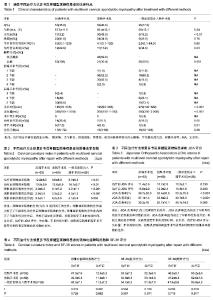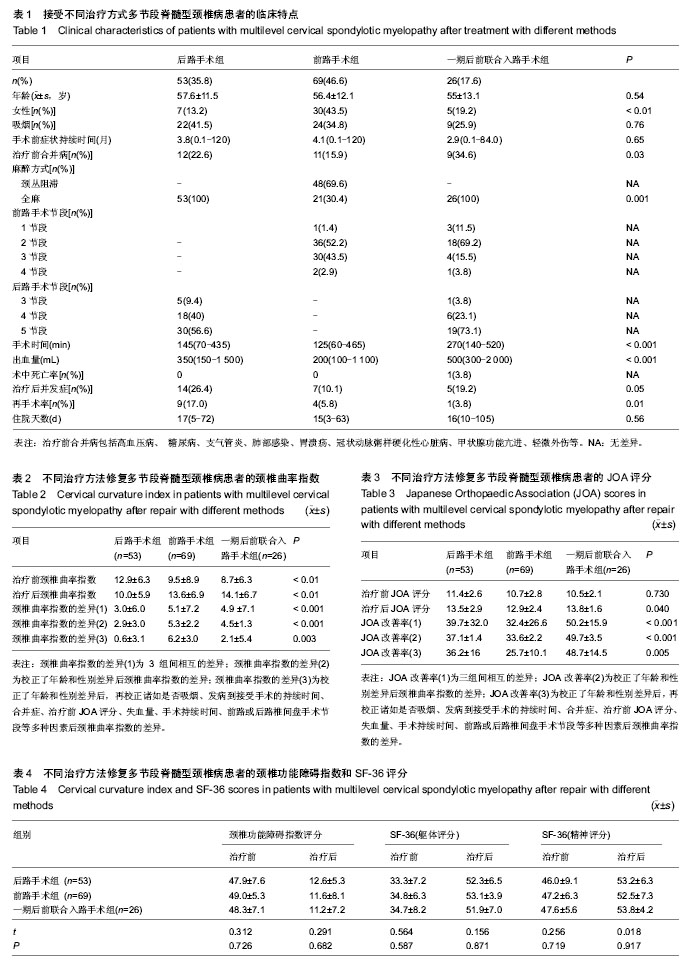Chinese Journal of Tissue Engineering Research ›› 2014, Vol. 18 ›› Issue (40): 6444-6450.doi: 10.3969/j.issn.2095-4344.2014.40.009
Previous Articles Next Articles
Treatment options and efficacy evaluation for multilevel cervical spondylotic myelopathy
Hou Zeng-tao1, Zhao Ai-lin1, Guo Chuan-you1, Chen Bo-hua2
- 1Qingdao Municipal Hospital, Qingdao 266011, Shandong Province, China; 2Affiliated Hospital, Medical College, Qingdao University, Qingdao 266011, Shandong Province, China
-
Revised:2014-08-25Online:2014-09-24Published:2014-09-24 -
Contact:Chen Bo-hua, Chief physician, Professor, Doctoral supervisor, Affiliated Hospital, Medical College, Qingdao University, Qingdao 266011, Shandong Province, China -
About author:Hou Zeng-tao, M.D., Attending physician, Qingdao Municipal Hospital, Qingdao 266011, Shandong Province, China
CLC Number:
Cite this article
Hou Zeng-tao, Zhao Ai-lin, Guo Chuan-you, Chen Bo-hua. Treatment options and efficacy evaluation for multilevel cervical spondylotic myelopathy[J]. Chinese Journal of Tissue Engineering Research, 2014, 18(40): 6444-6450.
share this article

2.1 各组患者一般资料比较 所有患者的手术入路选择在排除年龄、性别差异后比较差异无显著意义(P > 0.05)。表1说明接受多节段脊髓型颈椎病手术治疗的患者多集中在中、老年患者。 十分有意思的统计现象是本文纳入的患者中接受颈椎后路手术和一期后前联合入路手术的患者中以男性居多,而接受颈椎前路手术的患者中男女比例差异无显著性意义(P > 0.05)。3组患者在年龄、吸烟史及从发病到接受手术的持续时间方面无差异显著性意义(P > 0.05)。 接受一期后前联合入路手术的患者术前有更少的合并病,与其他2组的合并病率统计差异有显著性意义(P < 0.05)。 在手术的麻醉方式的选择上,2所医院在单纯后路手术和一期后前路联合手术时均采用全身麻醉,而单纯前路手术的患者中有69.6%选择了颈丛阻滞麻醉,麻醉方式差异有显著性意义(P < 0.001)。单纯前路组比一期后前路联合入路手术组中更多的患者接受了超过2个节段前路椎间盘的减压手术治疗(P < 0.001)。一期后前联合入路手术组比单纯后路手术组有更多的患者接受了5节段的后路减压治疗(P < 0.01)。 在3个手术治疗组中,一期后前联合入路手术组的平均手术时间最长,手术出血量最多,与单纯前路或单纯后路组比较差异有显著性意义(P < 0.001)。 单纯后路手术组发生术后并发症的可能更大(P < 0.05),手术失败再手术的概率更高(P < 0.01),术后并发症包括颈脊髓损伤(4例),喉上神经或喉返神经损伤(4例),颈部血肿(3例),食道瘘(2例),脑脊液漏(5例),椎动脉损伤(2例),颈椎轴性症状(2例),神经根麻痹(2例),术后再关门(3例),颈椎僵硬及生理曲度改变(7例)等。 2.2 不同治疗方法修复多节段脊髓型颈椎病患者颈椎曲率指数的变化 单纯后入路组的治疗前颈椎曲率指数最高,与单纯前入路组及一期后前联合入路组相比差异有显著性意义(P < 0.01)。治疗后评估可见一期后前联合入路组的颈椎曲率指数最高,与单纯前入路组及单纯后入路组相比差异有显著性意义(P < 0.01)。单纯前入路手术组的治疗前后的颈椎曲率指数变化最为明显(P < 0.01)。 在校正了年龄和性别差异后(校正后:5.2±1.2,P < 0.01),颈椎前入路组患者颈椎曲率指数变化差异有显著性意义(P < 0.01)。同时再校正诸如是否吸烟、发病到接受手术的持续时间合并症、术前JOA评分、失血量、手术持续时间、前路或后路椎间盘手术节段等多种因素后(校正后:6.7±3.0,P=0.004),颈椎曲率指数的差异依单纯后入路组、一期后前联合入路手术组至单纯前入路手术组的趋势逐步提高(P < 0.01;表2)。 2.3 不同治疗方法修复多节段脊髓型颈椎病患者的JOA脊髓功能评分 单纯后入路手术组治疗前JOA评分高于其他2组(P < 0.05),治疗后3组患者的JOA评分差异无显著性意义(P > 0.05),但治疗后一期后前联合入路手术组的JOA改善率与单纯前路或后路手术组相比较差异有显著性意义(P < 0.001)。在校正了年龄和性别差异后(校正后:51.2±2.1,P < 0.001)的1组,一期后前联合入路手术组的JOA改善率最高。再校正是否吸烟、发病到接受手术的持续时间、合并症、治疗前JOA评分、失血量、手术持续时间、前路或后路椎间盘手术节段等多种因素后(校正后:53.2±10.2,P < 0.01),2组JOA改善率呈现从单纯前入路手术组、单纯后入路手术组到一期后前联合入路手术组逐步提高的趋势(P < 0.01;表3)。 2.4 不同治疗方法修复多节段脊髓型颈椎病患者的颈椎功能障碍指数和SF-36评分 3组患者的随访颈椎功能障碍指数评分与其治疗前颈椎功能障碍指数评分比较差异有显著性意义(P < 0.01),但3组治疗前颈椎功能障碍指数评分及随访时的颈椎功能障碍指数评分差异无显著性意义 (P > 0.05)。3组患者治疗前与随访时的SF-36躯体评分及SF-36精神评分差异无显著性意义(P > 0.05;表4)。"

| [1] Seifert V, Stolke D. Multisegmental cervical spondylosis: treatment by spondylectomy, microsurgical decompression, and osteosynthesis. Neurosurgery. 1991;29(4):498-503.
[2] Edwards CC 2nd, Riew KD, Anderson PA, et al. Cervical myelopathy. current diagnostic and treatment strategies. Spine J. 2003;3(1):68-81.
[3] Lian XF, Xu JG, Zeng BF, et al. Noncontiguous anterior decompression and fusion for multilevel cervical spondylotic myelopathy: a prospective randomized control clinical study. Eur Spine J. 2010;19(5):713-719.
[4] Woods BI, Hohl J, Lee J, et al. Laminoplasty versus laminectomy and fusion for multilevel cervical spondylotic myelopathy. Clin Orthop Relat Res. 2011;469(3):688-695.
[5] Cabraja M, Abbushi A, Koeppen D, et al. Comparison between anterior and posterior decompression with instrumentation for cervical spondylotic myelopathy: sagittal alignment and clinical outcome. Neurosurg Focus. 2010; 28(3):E15.
[6] Guo Q, Bi X, Ni B, et al. Outcomes of three anterior decompression and fusion techniques in the treatment of three-level cervical spondylosis. Eur Spine J. 2011;20(9): 1539-1544.
[7] Kristof RA, Kiefer T, Thudium M, et al. Comparison of ventral corpectomy and plate-screw-instrumented fusion with dorsal laminectomy and rod-screw-instrumented fusion for treatment of at least two vertebral-level spondylotic cervical myelopathy. Eur Spine J. 2009;18(12):1951-1956.
[8] Shibuya S, Komatsubara S, Oka S, et al. Differences between subtotal corpectomy and laminoplasty for cervical spondylotic myelopathy. Spinal Cord. 2010;48(3):214-220.
[9] Aryan HE, Sanchez-Mejia RO, Ben-Haim S, et al. Successful treatment of cervical myelopathy with minimal morbidity by circumferential decompression and fusion. Eur Spine J. 2007;16(9):1401-1409.
[10] Konya D, Ozgen S, Gercek A, et al. Outcomes for combined anterior and posterior surgical approaches for patients with multisegmental cervical spondylotic myelopathy. J Clin Neurosci. 2009;16(3):404-409.
[11] Vernon H, Mior S. The Neck Disability Index: a study of reliability and validity. J Manipulative Physiol Ther. 1991; 14(7):409-415.
[12] Lin Q, Zhou X, Wang X, et al. A comparison of anterior cervical discectomy and corpectomy in patients with multilevel cervical spondylotic myelopathy. Eur Spine J. 2012;21(3): 474-481.
[13] Konya D, Ozgen S, Gercek A, et al. Outcomes for combined anterior and posterior surgical approaches for patients with multisegmental cervical spondylotic myelopathy. J Clin Neurosci. 2009;16(3):404-409.
[14] Baba H, Uchida K, Maezawa Y, et al. Lordotic alignment and posterior migration of the spinal cord following en bloc open-door laminoplasty for cervical myelopathy: a magnetic resonance imaging study. J Neurol. 1996;243(9):626-632.
[15] Takeshita K, Murakami M, Kobayashi A, et al. Relationship between cervical curvature index (Ishihara) and cervical spine angle (C2--7). J Orthop Sci. 2001;6(3):223-226.
[16] Hirabayashi K, Miyakawa J, Satomi K, et al. Operative results and postoperative progression of ossification among patients with ossification of cervical posterior longitudinal ligament. Spine (Phila Pa 1976). 1981;6(4):354-364.
[17] Ware JE Jr, Sherbourne CD. The MOS 36-item short-form health survey (SF-36). I. Conceptual framework and item selection. Med Care. 1992;30(6):473-483.
[18] Martin-Benlloch JA, Maruenda-Paulino JI, Barra-Pla A, et al. Expansive laminoplasty as a method for managing cervical multilevel spondylotic myelopathy. Spine (Phila Pa 1976). 2003;28(7):680-684.
[19] Iencean SM. Alternating cervical laminoplasty for cervical spondylotic myelopathy. J Bone Joint Surg Br. 2007;89(5): 639-641.
[20] Schultz KD Jr, McLaughlin MR, Haid RW Jr, et al. Single-stage anterior-posterior decompression and stabilization for complex cervical spine disorders. J Neurosurg. 2000;93(2 Suppl):214-221.
[21] DiAngelo DJ, Foley KT, Vossel KA, et al. Anterior cervical plating reverses load transfer through multilevel strut-grafts. Spine (Phila Pa 1976). 2000;25(7):783-795.
[22] Sasso RC, Ruggiero RA Jr, Reilly TM, et al. Early reconstruction failures after multilevel cervical corpectomy. Spine (Phila Pa 1976). 2003;28(2):140-142.
[23] Zdeblick TA, Hughes SS, Riew KD, et al. Failed anterior cervical discectomy and arthrodesis. Analysis and treatment of thirty-five patients. J Bone Joint Surg Am. 1997;79(4): 523-532.
[24] Mummaneni PV, Dhall SS, Rodts GE, et al. Circumferential fusion for cervical kyphotic deformity. J Neurosurg Spine. 2008;9(6):515-521.
[25] McAfee PC, Bohlman HH, Ducker TB, et al. One-stage anterior cervical decompression and posterior stabilization. A study of one hundred patients with a minimum of two years of follow-up. J Bone Joint Surg Am. 1995;77(12):1791-1800.
[26] McAfee PC, Bohlman HH. One-stage anterior cervical decompression and posterior stabilization with circumferential arthrodesis. A study of twenty-four patients who had a traumatic or a neoplastic lesion. J Bone Joint Surg Am. 1989; 71(1):78-88.
[27] O'Shaughnessy BA, Liu JC, Hsieh PC, et al. Surgical treatment of fixed cervical kyphosis with myelopathy. Spine (Phila Pa 1976). 2008;33(7):771-778.
[28] Sodeyama T, Goto S, Mochizuki M, et al. Effect of decompression enlargement laminoplasty for posterior shifting of the spinal cord. Spine (Phila Pa 1976). 1999;24(15): 1527-1532. |
| [1] | Du Shi-yao, Zhou Feng-jin, Ni Bin, Chen Bo, Chen Jin-shui. Finite-element analysis of a novel posterior atlantoaxial restricted non-fusion fixation system [J]. Chinese Journal of Tissue Engineering Research, 2017, 21(3): 383-389. |
| [2] | Sheng Xiao-lei, Yuan Feng, Li Zhi-duo, Yang Yu-ming, Lu Hai-tao, Zhang Jun-wei. Comparison of the accuracy of lower cervical anterior transpedicular screws between three-dimensional printing assembly navigation template and free hand placement [J]. Chinese Journal of Tissue Engineering Research, 2017, 21(3): 406-411. |
| [3] | Wang Xing, Zhang Shao-jie, Shi Jun, Li Xiao-he, Liu Ying, Li Zhi-jun, Hou Er-fei, Chen Jie, Wang Wei. Correlation of uncinate process and various vertebral body structures in adolescents: three-dimensional reconstruction based on CT images [J]. Chinese Journal of Tissue Engineering Research, 2017, 21(3): 412-417. |
| [4] | Zha Yuan-yu, Yang Yang, Zhou Yi-chi, Wei Ren-xiong, Zhang Shu-wei, Jin Wei. Meta-analysis of anterior screw fixation versus posterior cervical fusion in treatment of odontoid fractures [J]. Chinese Journal of Tissue Engineering Research, 2016, 20(48): 7288-7296. |
| [5] | Liu Ya-pu, Hou Xiu-wei, Wu Guang-liang, Xia Hong. Comparison of stress distribution of adjacent segments after artificial cervical disc replacement versus anterior cervical discectomy and fusion: a finite element analysis [J]. Chinese Journal of Tissue Engineering Research, 2016, 20(44): 6541-6548. |
| [6] | Gu Yong, Wang Qiang, Xin Tian-wen, Yang Hui-lin, Chen Liang . Posterior cervical open-door expansive laminoplasty with mini-titanium plate: correlation between cervical sagittal alignment and repair effect [J]. Chinese Journal of Tissue Engineering Research, 2016, 20(44): 6570-6576. |
| [7] | Wang Zhan, Li Hao-peng, He Xi-jing, Hao Ding-jun, Zhang Kun, Chen Ming-xia, Lei Ting. Pathological changes in the spinal cord of a model of acute cauda equina compression [J]. Chinese Journal of Tissue Engineering Research, 2016, 20(40): 5973-5978. |
| [8] | Wang Shi-jun, Li Yu-ting, Li Chun-de. Establishment, application and progression of an animal model of cervical spondylosis [J]. Chinese Journal of Tissue Engineering Research, 2016, 20(40): 6067-6073. |
| [9] | Li Xiao-feng, Qin Jun-jie, Li Qiang, Yang Yuan. Metacarpal bone reconstruction plate single-segment fixation in the repair of atlas fracture: biomechanical analysis of in vitro three-dimensional motion [J]. Chinese Journal of Tissue Engineering Research, 2016, 20(39): 5819-5824. |
| [10] | Yuan Feng, Lu Hai-tao, Deng Bin, Li Zhi-duo, Li Wei, Wu Ji-bin, Guo Kai-jin. Application of a three-dimensional printing model of surgical decompression for cervical ossification of the posterior longitudinal ligament [J]. Chinese Journal of Tissue Engineering Research, 2016, 20(39): 5852-5858. |
| [11] | Guan Jun-jie. Digital navigation enhances cervical pedicle screw placement accuracy and safety: study protocol of a randomized controlled trial [J]. Chinese Journal of Tissue Engineering Research, 2016, 20(39): 5898-5903. |
| [12] | Liu Miao, Shang Xian-wen, Ning Xu, Zhuang Yong, Xu Shun-en. Biomechanics and stability of the spine after implantation with pedicle screw and cervical vertebral screw fixation [J]. Chinese Journal of Tissue Engineering Research, 2016, 20(35): 5210-5215. |
| [13] | Zhai Peng-fei, Liu Wei, Sun Zhi-ming, Zhang Xue-li. Adjacent segment degeneration after anterior cervical corpectomy and fusion [J]. Chinese Journal of Tissue Engineering Research, 2016, 20(35): 5216-5223. |
| [14] | Hu Wei, Ma Xin-long, Yuan Jian-jun, Zhang Ren-zan, Peng Bing, Zhang Xue-li. Expression of interleukin-1 beta, interleukin-6 and cyclooxygenase 2 in cervical intervertebral disc of cervical spondylosis patients with different clinical symptoms [J]. Chinese Journal of Tissue Engineering Research, 2016, 20(35): 5270-5276. |
| [15] | Liang He-sheng, Xiao Li-jun, Deng De-li . Posterior cervical single door and double door laminoplasty for repair of multilevel cervical myelopathy: motion range of cervical vertebrae [J]. Chinese Journal of Tissue Engineering Research, 2016, 20(22): 3235-3241. |
| Viewed | ||||||
|
Full text |
|
|||||
|
Abstract |
|
|||||